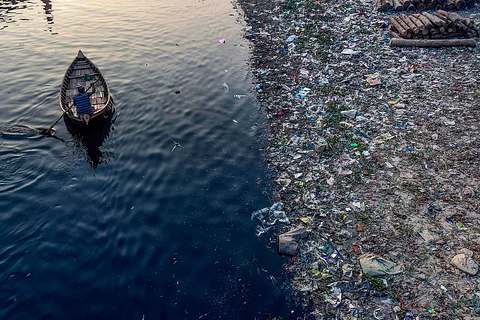The blue water of the river is now pitching black due to industrial waste and sewage pollution. Various aquatic animals, including fish, have disappeared. Giant sakar fish, known as the 'devil fish' in Mexico, have settled in the foul-smelling water. Such is the current condition of the capital's famous arteries, the Buriganga, Turag, Balu and Shitalakshya rivers. Despite various initiatives and hopeful political statements in the past decade, the rivers are still struggling with an existential crisis. Several research reports have found harmful heavy metals in rice and vegetables grown along the banks of the rivers. The fish have been found to contain various toxic chemicals and heavy metals, including micro plastics, which are causing various life-threatening diseases including cancer, the research report states.
In the past week, it was seen at various places in the rivers that the water has become thick and pitch black. There is a pungent stench in the water. Although the water of Shitalakshya seems to be relatively less polluted, the pollution of the Turag, Buriganga and Balu rivers has reached a terrible level. In the Ichhapura area of the Balu river, it is seen that gas is rising in the form of bubbles from the bottom of the river. Black dirt has accumulated on the ground on the banks of the river. The few fish that are still alive are dying due to lack of oxygen (repeatedly rising to the surface of the water).
In the Basila and Tongi areas, a picture of terrible pollution is also seen in the Turag river. The water is so black that you cannot see what three inches below is. It is difficult to stand near the river due to the stench. In the Babubazar and Sadarghat areas, the same picture is seen in the Buriganga river. People are crossing the river with handkerchiefs covering their noses. On the other hand, when fishermen cast their nets in the river, only giant, dirt-eating fish come up. It can be seen on the ground that as the water level in the river has receded due to the monsoon, the sewage lines for dumping waste into the river have become visible.
About 35 sewage lines and pipes have been seen within a kilometer from the Babubazar Bridge on the Buriganga River towards the original Buriganga. Water mixed with industrial and sewage waste has been seen flowing into the river continuously through these. A local boatman said that there are some pipes under the water as well. Piles of waste have been seen at various places on the river banks. However, the River Protection Commission had dreamed that the water of the four rivers surrounding Dhaka, including the Buriganga, would become clear and sparkling by March 2023. It was said that toxic, colorful industrial waste would no longer be allowed to flow into the river. There would be no need to hold a handkerchief to your nose due to the pungent smell of polluted, black water. Various species of fish would be swimming in the sparkling water. That dream remains elusive.
When asked about this, Syeda Rizwana Hasan, the interim government's environment, forest and climate change advisor, said, "We have identified river polluters. The situation in the sewage system is serious. Action will be taken soon in this regard. I have asked the Department of Environment to prepare a campaign action plan against those polluting Dhaka's rivers. In addition, I have received an action plan from all districts to seize and decontaminate one river. We will start the work after analyzing it and raising money. A study published in 'Environmental Science and Pollution Research' on July 12 showed that river pollution increased to dangerous levels between 2011 and 2020 compared to 2001-2010.
Dhaka's Buriganga River has been identified as the most polluted river in Bangladesh. The study found that the presence of 10 heavy metals (As, Pb, Cd, Cr, Fe, Mn, Cu, CO, Ni, Zn) in most of the rivers of Dhaka, Rajshahi and Chattogram divisions exceeded the limits set by the World Health Organization (WHO), the United States Environmental Protection Agency (USEPA) and the Department of Environment (DOE) of Bangladesh.
The study identified fertilizers and pesticides from agriculture, electroplating, textiles, tanneries and other industrial wastes as important causes of pollution. The River and Delta Research Center (RDRC), a surveying organization, found 237 sewage spills and 251 sewage lines in the Buriganga River, 131 sewage spills and 99 sewage lines in the Turag River (including the Tongi Canal) and 32 sewage spills and 10 sewage lines in the Balu River in November-December 2019, based on field surveys, GPS maps and satellite imagery. The organization tested the water of 56 rivers in Bangladesh at the Greenbird Lab in Gazipur and published a report last year. It found that all 56 rivers contained dangerous levels of plastic and chemical pollution. Due to chemical pollution, the dissolved oxygen in the water of the Buriganga, Turag, Tongikhal, Shitalakshya, Dhaleshwari, Luandaha, Lower Banar, Old Brahmaputra, Titas, Chilai, Sutang, Banshi, Haridhwa, and Karnaphuli rivers is sometimes dropping below 2 milligrams, whereas at least 5 milligrams of oxygen is essential for the survival of aquatic animals including fish.
In this regard, the chairman of the organization, Mohammad Ejaz, said, "We are regularly monitoring the rivers. Not a single sewage line has been closed in the last five years. Currently, the pollution has increased further. We have made an action plan and given it to the current interim government to stop the pollution. If it is implemented, pollution will be reduced by 40 percent. The cost will not be high either.
Earlier, a study published in the international journal Science of the Total Environment in October 2022 showed that harmful microplastics and heavy metals are present in dangerous levels in the soil, water, fish, snails, and crabs of the Buriganga River. The amount of microplastics in these was 0.12-0.25 t/ml in water, 3.5-8.17 t/g in soil, 0.65-3.82 t/g in fish, 3.75-4.28 t/g in snails and 0.84-1.12 t/g in crabs respectively.
In addition, the head of the research team, Md Mostafizur Rahman said that 37.68 mg of arsenic, 153 mg of chromium, 8.32 mg of cadmium and 87.12 mg of lead were found per kg of soil. Similarly, the presence of arsenic, chromium, cadmium and lead per liter of water was 36.62 micrograms, 146.66 micrograms, 8.16 micrograms and 81.72 micrograms respectively. They enter the body through the food chain and can cause cell damage, immunological changes, genotoxicity, endocrine disruption, neurotoxicity, reproductive abnormalities and behavioral changes.
ZH






